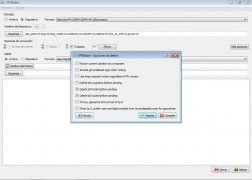

- #Gpsbabel invalid return data at line 3 how to#
- #Gpsbabel invalid return data at line 3 series#
- #Gpsbabel invalid return data at line 3 windows#
This tile is passed back to the client and moves on to the next item in the queue.įor rendering, OpenStreetMap data is stored in a PostgreSQL database created by a tool called osm2pgsql. It pulls requests from the work queue as fast as possible, extracts data from various data sources according to the style information, and renders the tile. We use a tool called Mapnik to render tiles. If it does need to be rendered, then it will add it to a "render request" queue, and when it gets to the top of the queue, a tile renderer will render it and send the tile back to the client. If it is already available and doesn't need to be rendered, then it immediately sends the tile back to the client. Mod_tile checks if the tile has already been created and is ready for use or whether it needs to be updated due to not being in the cache already. Once Apache handles the request from the web user, it passes the request to mod_tile to deal with. The Apache web server can also be used to serve static web content like the HTML, JavaScript, or CSS for your map webpage.
#Gpsbabel invalid return data at line 3 series#
We use a series of tools for generating and serving map tiles:Īpache provides the front end server that handles requests from your web browser and passes the request to mod_tile. In this example we'll use it simply to show the map that you render, but to learn more about extending it to include these features, please visit.
#Gpsbabel invalid return data at line 3 windows#
It is very powerful and can be used to add advanced features to your map like buttons, overlays, popup windows and lines. OpenLayers is a JavaScript library for displaying maps on your web site. The OpenLayers library we are using in this example will place these tiles in a grid to form a draggable view of anywhere on the Earth. What are tiles?įor our purposes, a web map is made up of several adjacent square images, each 256 pixels square, that cover a particular geographic region of the Earth. In general, requirements will range from 10-20GB of storage, 4GB of memory, and a modern dual-core processor for a city-sized region to 300GB+ of fast storage, 24GB of memory, and a quad-core processor for the entire planet. Depending on the size of the area you're interested in serving and the traffic you expect the system requirements will vary. Serving your own maps is a fairly intensive task. You might want to do this if you are interested in highlighting a particular kind of OpenStreetMap data like bicycle or foot paths or if you are dissatisfied with the elements present in the other available map styles.


#Gpsbabel invalid return data at line 3 how to#
In this chapter we'll go farther by describing how to set up your own server with a customized map style based on OpenStreetMap data. This is similar to the earlier section in this book describing the "Export" tab on. The most basic and easiest for you to use is a JavaScript library called OpenLayers that provides a draggable map that you can embed on your own webpage. There are many different options for providing maps on your own web site.


 0 kommentar(er)
0 kommentar(er)
